![]() The New York Yankees have have had a rough offseason thus far.
The New York Yankees have have had a rough offseason thus far.
It began with an all too public dispute with free agent SS Derek Jeter, who eventually re-signed with the team, but only after sniping and vitriol were exchanged by the two sides during (and in the aftermath of) negotiations.
Then they were spurned by free agent left-hander Cliff Lee, who took less money than the Yankees had offered in order to accept a return engagement with the Philadelphia Phillies.
And while they were successful in securing free agent Mariano Rivera’s autograph on a contract, they haven’t been so fortunate with southpaw Andy Pettitte, who may hold the fortunes of the organization in his left hand.
These dramas have played out on the back pages of the New York City newspapers at the same time that their mortal rivals, the Boston Red Sox, have enjoyed what is the most productive offseason in franchise history, adding 1B Adrian Gonzalez, OF Carl Crawford and relievers Bobby Jenks and Dan Wheeler to an already formidable ballclub. Crawford, the Yankees “Plan B” this ofseason, was signed by the Red Sox while Hank Steinbrenner and GM Brian Cashman fiddled around, awaiting word from Lee—their “Plan A”.
Ridiculed by the papers, maligned by their fan base and surpassed in talent by their arch-rivals to the north, the Yankees began to appear desperate in spite of the protestations to the contrary by their general manager.
![]()
Most of the Yankees’ opportunities to improve had been lost to the front office. Aside from Pettitte, the only other of the top ten free agents that remains unsigned is starter Carl Pavano, and they have been there, done that with the former Red Sox farmhand. If they do not re-sign Pettitte or add another impact starter through free agency, two other options are available to the Yankees:
1) sign a free agent setup man and then include Joba Chamberlain in a deal (along with top prospect Jesus Montero and others) for a front-line starter
2) sign a free agent reliever and then rely on the bullpen to compensate for a rotation that will have rookie Ivan Nova and another marginal pitcher at the back end
The best of the free agent relievers that remained available as of yesterday was former Braves and Rays closer Rafael Soriano, who has been seeking a three year deal—preferably to serve as some team’s closer. But the market never materialized for him—in large part due to the fact that he was designated a Type A free agent (requiring the signing team to forfeit a draft pick). In response to recent speculation that the Yankees needed to sign Soriano to act as their 8th inning setup man, a defiant Cashman declared he would not surrender his first round pick for any of the remaining free agents.
Apparently that all changed last night.
In an act that bears all of the hallmarks of pure desperation, the Yankees agreed to a three year, $35 million contract with Soriano, who will serve as Mariano Rivera’s primary setup man. The deal will allow the right-hander to opt out of his contract after either the first or second year of the deal. So, Cashman surrendered his first round draft pick for a player who may turn out to be a one year rental. Wow!
![]()
Soriano led the American League in saves last season (45) and will become the highest paid setup man in the history of the game. The cheering you are hearing is coming from the home of free agent southpaw Brian Fuentes, who remains unsigned.
The Yankees don’t care that they have once again hurt the game of baseball ($11.67 M per year for a set-up guy?). They were in desperate straits trying to chart a course for 2011, and so they did what they felt like they had to do.
The bullpen as currently constituted is arguably the best in the game of baseball, with Rivera and Soriano heading up a relief corps that includes Joba Chamberlain, Dave Robertson and Pedro Feliciano, among others. But I have a sense that there is another shoe that has yet to drop…
I cannot imagine the Yankees going into the 2011 season with a payroll in the vicinity of $200 million and a rotation that includes Nova and some as-yet-unidentified journeyman. Maybe Soriano will help convince Pettitte he should pitch for one more year…or maybe he frees up Chamberlain to be dealt. Either way, it seems likely that Steinbrenner and Cashman aren’t done yet.
The betting here is that Pettitte—who desperately wants to win—will finally decide to return to the Yankees to make another run towards a World Series ring.
As for Soriano, he makes the Yankees bullpen a force to be reckoned with and provides the club with an heir-apparent for Rivera.
![]()
He was an All-Star last year, going 3-2 with 45 saves and a 1.73 ERA. He allowed just 36 hits in 62.3 innings pitched while striking out 57 batters. He and Rivera combined for a 1.77 ERA and a .173 opponents’ batting average (122.3 IP, 75 hits) last year, to go along with 102 strikeouts and 25 walks. THAT is a formidable tandem.
But there is a downside here for the Yankees: Soriano didn’t miss as many bats last year as he had in previous years (his K-rate decreased by one-third last year), and he is a fly ball pitcher who will now pitch in a ballpark that often resembles an over-sized softball diamond. Caveat emptor, Brian.
Soriano doesn’t make up for losing out on Lee or Crawford, but it’s the best the Yankees could do at this point of the offseason—time will tell whether it was a stroke of genius or a mad act of desperation.
For this and more articles written by Jeffrey Brown, you can visit his website here.
Read more MLB news on BleacherReport.com

